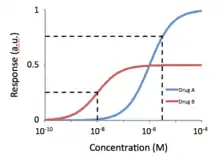Potency (pharmacology)
In the field of pharmacology, potency is a measure of drug activity expressed in terms of the amount required to produce an effect of given intensity.[1] A highly potent drug (e.g., fentanyl, alprazolam, risperidone, bumetanide, bisoprolol) evokes a given response at low concentrations, while a drug of lower potency (meperidine, diazepam, ziprasidone, furosemide, metoprolol) evokes the same response only at higher concentrations. Higher potency does not necessarily mean greater effectiveness or more side effects.

Concentration-response curves illustrating the concept of potency. For a response of 0.25a.u., Drug B is more potent, as it generates this response at a lower concentration. For a response of 0.75a.u., Drug A is more potent. a.u. refers to "arbitrary units".
The IUPHAR has stated that 'potency' is "an imprecise term that should always be further defined",[1] for instance as , , , and so on.
See also
- Reaction inhibitor § Potency
References
- Neubig RR, Spedding M, Kenakin T, Christopoulos A (December 2003). "International Union of Pharmacology Committee on Receptor Nomenclature and Drug Classification. XXXVIII. Update on terms and symbols in quantitative pharmacology". Pharmacol Rev. 55 (4): 597–606. doi:10.1124/pr.55.4.4. PMID 14657418.
Further reading
- Harris, Robert (2012-10-09). "Formulating High Potency Drugs". Contract Pharma. Retrieved 2013-11-13.
- Walker MG, Page CP, Hoffman BF, Curtis M (2006). Integrated Pharmacology (3rd ed.). St. Louis: Mosby. ISBN 978-0-323-04080-8.
This article is issued from Wikipedia. The text is licensed under Creative Commons - Attribution - Sharealike. Additional terms may apply for the media files.